Squid Game meets Blade Runner: inside the secret world of the gig economy
This wild project by Korean artist Ayoung Kim reminds us of the faceless people who bring us food.
By Jessica Yu

Credit: ACMI
Like most of us, Korean artist Ayoung Kim thought a lot about loneliness when the world locked down at the height of COVID-19. But it was not just her own predicament that occupied her. Kim became fascinated with what it meant for the food-delivery drivers who were keeping many of us fed. Already rendered anonymous by the nature of their work, they were further isolated by the pandemic – dropping food at our doors and leaving quickly, minimising the risk of human contact.
“The reason I started this project was ... my own experience of ordering food almost every day during the pandemic,” Kim says via Zoom from her Seoul studio. “People in South Korea, they’re crazy about the speed and velocity and this efficiency ... this gave me this question of what kind of people they are who run so fast and who work so hard to get more delivery work to get more money, and they are really invisible for the customers.”
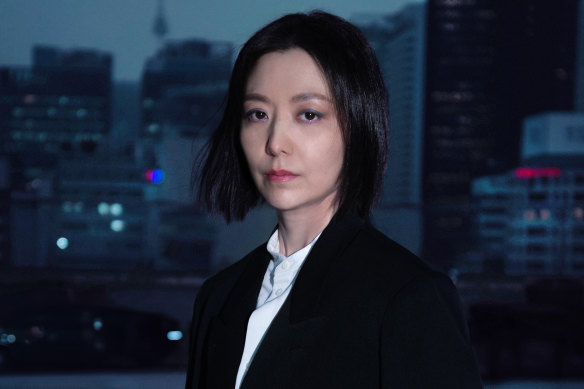
Ayoung Kim’s most ambitious work to date was inspired by the plight of delivery riders.Credit: ACMI
The question turned into a two-year project to create a speculative, multi-layered artwork that is now showing across three screens inside a dedicated room at ACMI. Delivery Dancer’s Arc: 0° Receiver (a sequel of sorts to her award-winning 2022 work Deliver Dancer’s Sphere) is the artist’s most ambitious project yet and uses a combination of traditional filmmaking methods, CGI and video game techniques.
In creating the work, Kim led a team of almost 50 people, including designers, animators, game developers, filmmakers, dancers, martial arts choreographers and actors. She also consulted academics in disciplines as diverse as pure maths, physics and philosophy. The result references everything from Eastern philosophy to Korean sci-fi and the unnerving cinematic device of the doppelgänger. Time, and the urge to defy it, is central.
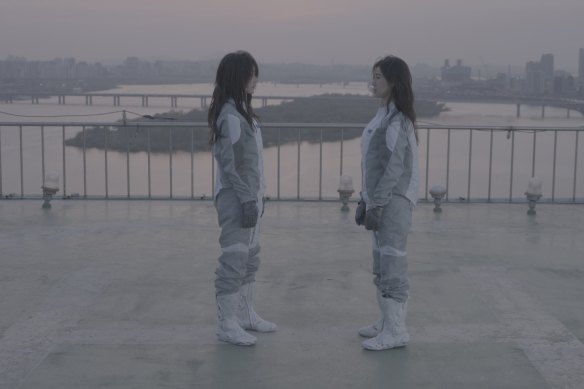
Ernst Mo with her doppelganger, En Storm.Credit: Ayoung Kim
At its heart is a female delivery driver, Ernst Mo (an anagram for monster), who is occasionally accompanied by her doppelgänger, En Storm. The pair soar through the world at dizzying speed, echoing the frenzied pace of a delivery shift.
When we meet Mo, she is speeding through an ancient desert landscape before riding off a cliff face and falling into another dimension: a futuristic Asia that she mediates through the delivery app on her phone.
It’s a wild ride that crosses rocky desert landscapes, anonymous freeways and gritty city laneways. Think Squid Game meets Blade Runner, with occasional David-Lynchian hints of menace. Kim’s movie-like spectacle opens on the vernal equinox, when the sun is exactly above the equator. It is the only occasion when GPS tracking is disrupted, allowing the rider to cheat time.
The work, says Kim, is “about this female delivery rider who just fell into this endlessly labyrinthine navigation path ... the [harder she worked], the more delivery work [keeps coming to her]. And she always got urged by the algorithm to be faster and faster. So it seems that in this fiction, there’s no way to escape from this algorithm-driven navigation.”
As part of her research, Kim joined delivery-driver Facebook groups and eventually accompanied one rider as she journeyed across Seoul making deliveries. The woman’s life was controlled by the app she was using, which mapped her route algorithmically, and constantly sent her messages and notifications to maximise her productivity, scheduling multiple deliveries at once.
But Kim also realised that alternative pirate apps allowed the woman to trick the system into thinking she was closer to the drop-off point than she was. She got more work that way. In what the artist describes as “a kind of activism”, the gig workers were using their invisibility to their advantage.
“It’s quite interesting to see, she’s not just a passive gig worker,” Kim says. “She’s invisible, but she knows how to utilise it in that way.” At one point, the rider is warned against trying to defy time; later, she pleads: “Leave my time alone”.
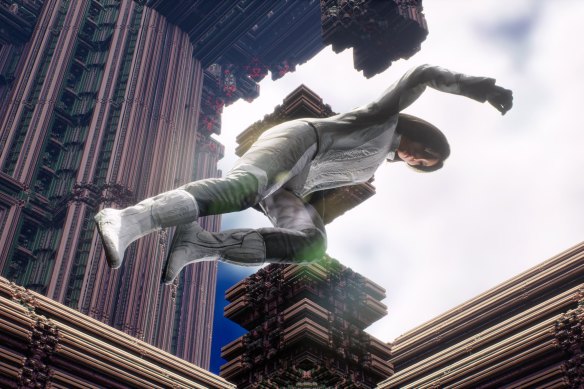
Delivery Dancer’s Arc: 0° Receiver sees Ernst Mo speeding through space and time.Credit: Ayoung Kim
Kim is interested in ways of understanding time that predate the Gregorian calendar; in various cultures, time’s passage was calculated using astronomy, superstition, fortune-telling and feng shui, before modernity “wiped out” these alternative measures. As part of her research, she visited the Jantar Mantar, the world’s largest sundial in Jaipur, India, which features prominently in the work.
Delivery Dancer’s Arc: 0° Receiver is set in an imagined and future Asia and across several ancient dimensions; the delivery driver traverses space and time in an unknown future landscape to make endless deliveries. The setting is inspired by Kim’s interest in Asia-Futurism, which subverts the Western gaze by imagining a future Asia that is for and about the lives of Asian people.
Kim thinks of her work as a decisive break with and form of redress to Hollywood narratives in which a futuristic Asia and robotic Asian characters serve as a backdrop for a white protagonist. In her work, the Asian protagonist is always guiding the narrative; she “feels the problems” of her world, yet endures.
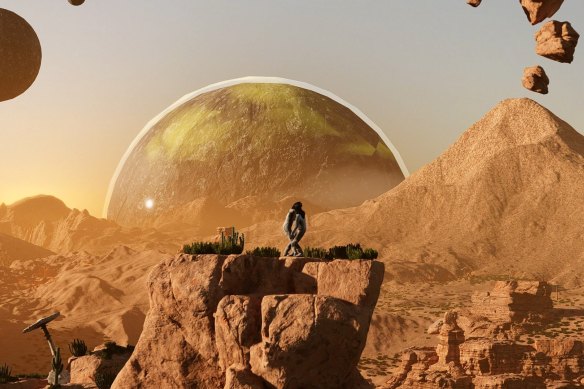
Moments of tenderness between Ernst Mo and En Storm are fatal to her delivery job.Credit: Ayoung Kim
Against the burden of anonymity, human connection becomes a source of comfort. Ernst Mo and En Storm share a deep affection for one another and in the moments when they meet, they caress, making balletic shapes with their bodies as they intertwine.
These brief moments of tenderness are fraught because they slow things down, making it impossible to complete their deliveries on time. “Whenever they encounter or meet, time becomes slower, which is fatal to her delivery job,” says Kim.
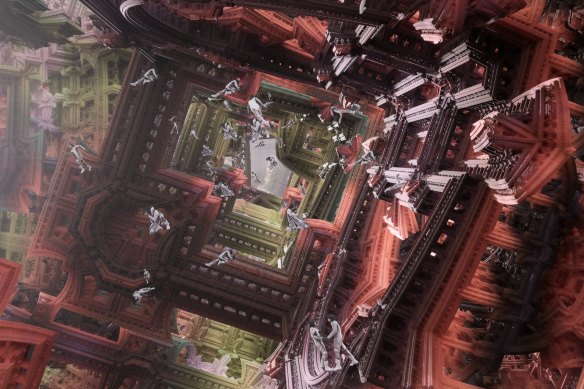
The setting is inspired by Ayoung Kim’s interest in Asia-FuturismCredit: ACMI
The tension between the desire to be together and the demands of surviving in the gig economy creates a deep longing that cannot be fulfilled in their world. Perhaps, this is the bittersweet hope at the heart of Kim’s work: the impossibility of tenderness in the hard face of time under capitalism.
Delivery Dancer’s Arc: 0° Receiver is in Gallery 2 at ACMI until January 2, 2026.